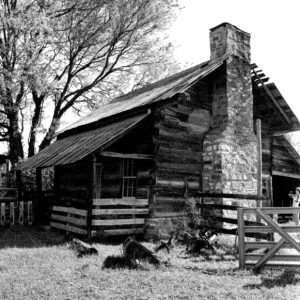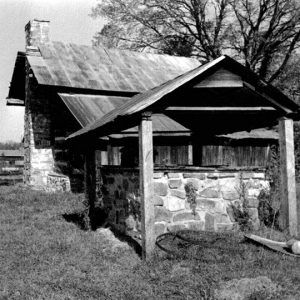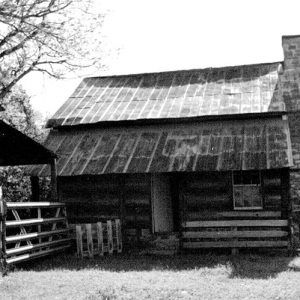calsfoundation@cals.org
Barron-Craig House
The Barron-Craig House, the oldest structure still standing in northern Saline County, is located at Paron near the intersection of Arkansas Highway 9 and Kanis Road (12th Street). It is one of only a few antebellum homes still found in Saline County. A single-pen log structure, it survived the destruction of the Civil War and the ravages of time.
James Barron moved to Saline County from South Carolina circa 1835 and settled in Union Township, later designated Holland Township, near what became Paron. His son, John T. Barron, born in 1828, married Sarah Pelton in 1856 and began a farmstead nearby. In 1857, John Barron built a single-pen log structure with a gabled roof on a foundation of stone piers and a cut-stone chimney of local rock.
In 1861, he enlisted in Company C, Third Arkansas Cavalry, a Saline County Confederate unit. Serving initially as a private/sergeant in the quartermaster’s department, he was elected first lieutenant in May 1862. He and his unit served briefly under the command of Major General Nathan Bedford Forrest and, for the remainder of the war, under Major General “Fighting Joe” Wheeler. Barron participated in battles including Corinth and Holly Springs, Mississippi; Thompson’s Station and Knoxville, Tennessee; Chickamauga and Atlanta, Georgia; and the last battle of Bentonville, North Carolina. Although never wounded, he almost drowned on August 11, 1863, in the Clinch River in Tennessee. Barron surrendered with the remnant of his unit at Chesterfield, South Carolina, on May 5, 1865.
Upon returning from the war, he continued farming and then sold his farm and home to Thomas Y. Craig circa 1877. Craig, born in South Carolina in 1838, moved to the vicinity of Nashville (Howard County) in 1859 with his parents. At the outbreak of war, he enlisted in Company F, Fifth Arkansas Infantry State Troops, the Davis Blues, and participated in the Battle of Oak Hills, Missouri. Afterward, the unit disbanded, and he enlisted in Company I, Nineteenth (Dawson’s) Arkansas Infantry, initially serving as a teamster. He was captured at the Battle of Arkansas Post in January 1863 and sent to Camp Douglas, Illinois, as a prisoner of war. Upon release in August, his unit was placed in the Army of Tennessee, serving in the Western Theater the remainder of the war. Craig participated in the battles of Chickamauga; Lookout Mountain; those of the Atlanta campaign; Franklin and Nashville, Tennessee; and the last at Bentonville, North Carolina. He was included in the surrender by General Joseph Johnston on April 26, 1865.
After the war, he returned to Nashville before moving to Little Rock (Pulaski County) in 1866 to become a carpenter. He married Sarah Jane Ray in 1870 and moved to Holland Township, purchasing the Barron farm. Craig farmed, opened a store, became the local justice of the peace, and joined Paron Lodge Number 319, Ancient Free and Accepted Masons. Initially, the local neighborhood was known as Brazils but became unofficially known as Craigtown. A request was made to name the post office in his honor but was refused by the Postal Service, which named it Paron in 1909.
After his wife Sarah died, Craig married Emily Brashears in 1879; they had six children. Additions to the original structure were made to make more room. A weatherboard dogtrot wing was added with a dining room and kitchen in an L-shape to the rear. This portion eventually deteriorated and was removed, leaving the original structure.
The home was a local community gathering place, hosting square dances and even a traveling circus out of Little Rock, at which Craig shook hands with a trained bear. After Emily died, Craig married Mary McAllister in 1904; they divorced in 1917. He then sold the farm to his son-in-law, Thomas Green. Craig died in 1921 and is buried in the local Fowler Cemetery. The farm was later sold in 1925 to W. F. Greenway, whose descendants still own the home and property.
Preserving the rural nineteenth-century agricultural setting, the home was listed on the Arkansas Register of Historic Places on September 7, 2000. This nomination was based on Criterion C due to its antebellum single-pen construction, and Criterion A as the earliest extant dwelling still remaining in Paron. As a result of changes and alterations, it was ineligible for listing on the National Register of Historic Places. If they are reversed, a nomination would be possible in the future.
For additional information:
“Barron-Craig House.” Arkansas Register of Historic Places. https://www.arkansasheritage.com/arkansas-historic-preservation-program (accessed May 8, 2024).
Dunnahoo, Pat. “The Old Craig House in Saline County Holds A Wealth of Unusual State History.” Arkansas Gazette, July 14, 1968, p. 6E.
Krueger, Marlo B. “Barron-Craig House, Paron, Arkansas.” The Saline 39 (Spring 2024): 39–47.
Anthony Rushing
Benton, Arkansas


 Barron-Craig House
Barron-Craig House  Barron-Craig House
Barron-Craig House  Barron-Craig House
Barron-Craig House 



Comments
No comments on this entry yet.